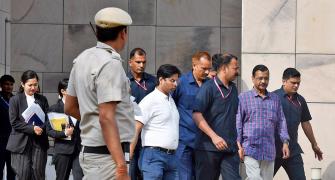The bull run in the domestic animation industry appears to have lost steam mid-way. While 2009 has an impressive line-up of releases, industry sources confirm that some of these projects were being delayed by 2-3 months.
A case in point is of Sultan the Warrior, an animated film featuring Rajnikanth, which was to be released by end-2008. But many in the industry are not sure when the film will be released. "Many producers, marketers and distributors are putting their animation plans on hold and are investing in low-budget movies that will at least give them some returns. This is because even an animation film requires anything between Rs 8 and Rs 10 crore (Rs 80-100 million)," said a source from a leading production house.
The reason for the sluggishness, perhaps, is what happened last year. The animated industry made significant progress in the year 2008 with five major animated theatrical releases, but none was a box-office hit. All movies under major banners failed to impress the audience including Walt Disney and Yash Raj films' Roadside Romeo, Elecom Fiesta's Cheenti Cheenti Bang Bang, Shemaroo's Ghatotkach, Phoebus' Dashavtar or the celebrity-backed film Jumbo.
These films were backed by huge marketing budgets. It was reported that Jumbo had a marketing budget of Rs 4.5 crore (Rs 45 million). Roadside Romeo was backed by Disney, which added to its marketing blitz. Visual Effect Society had nominated Tata Elxsi for animation work in Roadside Romeo along with movies like Wall-E, Kung Fu Panda and Waltz with Bashir and Bolt.
"There is a bit of delay in projects, partly due to production issue and the rest, of course, due to the financial crunch. There is an overall sentiment to hold onto investments. While the project might have been announced last year, the investment would happen in stages and in some cases it has got impacted," said an industry source from a leading visual effects studio which had a major release in 2008. He further added that we certainly need to rethink our strategy as far as animated movies are concerned.
"Yes, there is a bit of a slowdown in the film segment. But that is more due to a lag effect and nothing to do with the recession. I would still say that movies that were to be released in 2009 will release as per the schedule. But the next round of movie release will depend on how these perform at the box-office," said Jai Natrajan, executive VP and business head, Animation Services, Maya Entertainment.
Industry players also feel that the animation sector is still in its infancy and got too much hype initially. The best example of this is Yash Raj Films Roadside Romeo. "The concept was good on paper but the audience was mixed up," said an industry trader.
"The Indian market is not fully-matured for animated products. Disney, Sony and Cartoon Network are committed towards building the animated market in India, however till the content does not meet high-quality standards it will continue to remain a challenge. Multiple small studios which do not have sustainable business models are beginning to feel the heat" said AK Madhavan, chief executive officer, Crest Animation Studios.
Tapaas Chakravarti, CEO, DQ Entertainment feels that the business model still needs to mature. "World over about 50-60 per cent of revenues for an animated film come from the box-office and the rest is contributed by homevideos, TV, publications and others. But in India, box-office contribution is 100 per cent. In this case again, the business model needs to be different and you need multiplex's as your partner," he added.
The other problem is that of content. Chakravarti believes that one has to cater for two age groups that is, parents and children. "Moreover, the quality of the story telling and looks have to be good as Indian viewers are used to Bollywood movies which have a lot of spice in them," he adds.
The other issue is that of pricing and distribution. "How the movie is positioned and marketed also matters. How many prints will be distributed is another issue. Because of the cost, if the prints are less then it is difficult for the movie to penetrate into the markets and at the same time the audience gets impacted," said an industry expert.
These are precisely some of the reasons that have kept the Indian studios away from the domestic market. "Despite being in the industry for some time now, we decided not to venture in the domestic market. It still needs to mature, especially in terms of the revenue model. We are working on the domestic market and in a few months we will announce something. But it will certainly not be in the mythology space," added Madhavan.
Despite all the challenges, all those who have been able to work successfully with the global partners are now looking at exploring the domestic market through different segments. They do believe that India has a huge opportunity in animation and the current lull is just temporary.
"We are coming up with a series of Ravan with Turner Networks Asia to be showcased on Turners leading channels' in India in 2009. We have also bagged the rights for Satyajit Ray's movies meant for children. We will look at short documentaries, then mould them into series and if successful we will also launch some of them as movies," confirmed Chakravorti.







